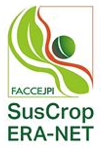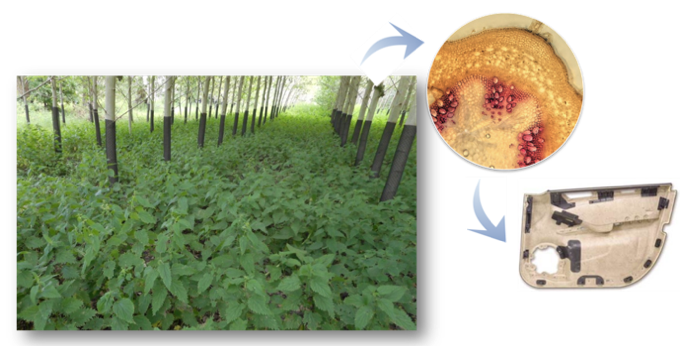 The sharp increase in demand for sustainable, bio-based fibres as substitute for man-made fibres (e.g. synthetic fibres or glass fibres) in products as diverse as textiles and automotive parts can only be met by an increased land area usage. However, land, as most important means of production, is a scarce resource and there is a perceived land-use conflict between the needs of food production and non-food production. Producing non-food crop on land marginalised, for example, by contamination, which is unsuitable for food production might help mitigate this conflict. Nettle (Urtica dioica) has a long history as fibre crop, but is scarcely used in modern times. However, the rediscovered special properties of nettle fibres (length, strength, fineness) have led to an increasing market interest in their use. Nettle is now emerging as an important “new” fibre crop. It also seems particularly well suited to be cultivated on marginal land. The spontaneous appearance of dioecious nettle is prevalent in short rotation coppice (SRC) cropping systems, especially at phytomanaged marginal land sites. Nettles and coppice, such as poplar coppice, provide a multilevel canopy and production of both biomass for energy (coppice) and biomass for fibre (nettle). Nettle is extending the productivity of the marginal land from coppice alone, whilst maintaining a functioning phytomanagement system of rehabilitation and risk management of the marginal land.
The sharp increase in demand for sustainable, bio-based fibres as substitute for man-made fibres (e.g. synthetic fibres or glass fibres) in products as diverse as textiles and automotive parts can only be met by an increased land area usage. However, land, as most important means of production, is a scarce resource and there is a perceived land-use conflict between the needs of food production and non-food production. Producing non-food crop on land marginalised, for example, by contamination, which is unsuitable for food production might help mitigate this conflict. Nettle (Urtica dioica) has a long history as fibre crop, but is scarcely used in modern times. However, the rediscovered special properties of nettle fibres (length, strength, fineness) have led to an increasing market interest in their use. Nettle is now emerging as an important “new” fibre crop. It also seems particularly well suited to be cultivated on marginal land. The spontaneous appearance of dioecious nettle is prevalent in short rotation coppice (SRC) cropping systems, especially at phytomanaged marginal land sites. Nettles and coppice, such as poplar coppice, provide a multilevel canopy and production of both biomass for energy (coppice) and biomass for fibre (nettle). Nettle is extending the productivity of the marginal land from coppice alone, whilst maintaining a functioning phytomanagement system of rehabilitation and risk management of the marginal land.
The NETFIB consortium is very pleased with the manifold and interdisciplinary project and sees the overall aim of NETFIB “to develop the capacity for farmers and other land managers to recover nettle as a fibre crop from marginal lands, which would otherwise remain under-used.”
Overall, NETFIB combines experimentation for nettle biomass production on land and the processing of its fibre outputs, as well as potential constraints, for example transfer of contaminants into usable biomass, and sets all of this information in a broader context of commercial feasibility and sustainability.
Combining the skills of academic and industrial partners from France, Germany, Austria, the United Kingdom and Italy is the basis to merge the technical and economic aspects of the development of this sector throughout the complete value chain.
So far, first important steps were achieved in the project regarding sustainability evaluation of nettle sites, nettle fibre extraction, testing organic and biological amendments in nettle leafs and roots and development of adjusted mechanical nettle fibre testing.

Project consortium
- Coordinator: Université Bourgogne Franche-Comté (UBFC), Laboratoire Chrono-environnement & laboratoire FEMTO-ST, France; Prof. Michel CHALOT
- INOVYN, France; Dr. David CAZAUX
- Université de Lorraine (UL), Laboratoire Interdisciplinaire des Environnements Continentaux (LIEC), France; Dr. Damien BLAUDEZ
- Università Cattolica del Sacro Cuore (UCSC), Department of Sustainable Crop Production, Italy; Prof. Stefano AMADUCCI
- r3 environmental technology ltd (R3E), United Kingdom; Prof. Paul BARDOS
- Leibniz Institute for Agricultural Engineering and Bioeconomy (ATB), Post-Harvest Technology, Germany; Dr. Hans-Jörg GUSOVIUS
- University of Natural Resources and Life Sciences Vienna (BOKU), Department of Forest and Soil Sciences, Austria; Dr. Markus PUSCHENREITER
- Hochschule Bremen – City University of Applied Sciences (HSB), The Biological Materials Group / Biomimetics / Faculty 5, Germany; Prof. Jörg MÜSSIG
Acknowledgement
This project receives funding from the European Union’s Horizon 2020 research and innovation programme under grant agreement No 771134. The project NETFIB is carried out under the ERA-NET Cofund SusCrop (Grant N°771134), being part of the Joint Programming Initiative on Agriculture, Food Security and Climate Change (FACCE-JPI).
Source
Hochschule Bremen, press release, 2020-10-09.
Supplier
Hochschule Bremen
INOVYN
Leibniz-Institut für Agrartechnik Potsdam-Bornim e.V. (ATB)
r3 environmental technology ltd
Università Cattolica del Sacro Cuore
Universität für Bodenkultur Wien (BOKU)
Université Bourgogne Franche-Comté UBFC
Université de Lorraine
Share
Renewable Carbon News – Daily Newsletter
Subscribe to our daily email newsletter – the world's leading newsletter on renewable materials and chemicals









